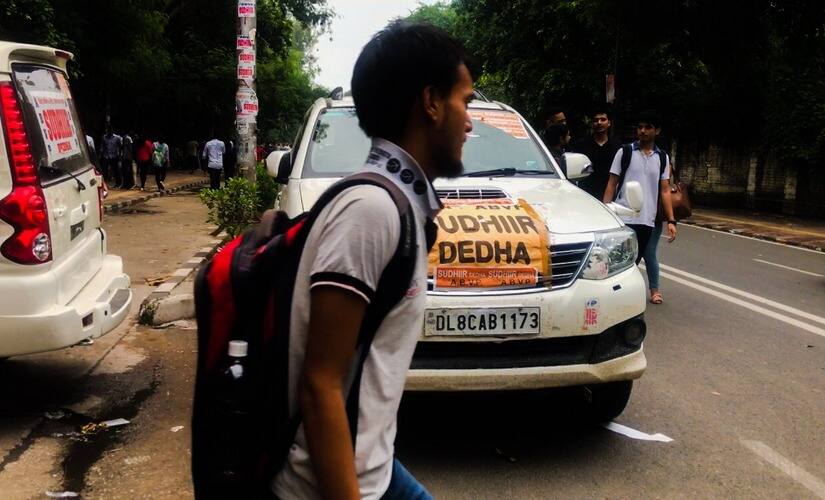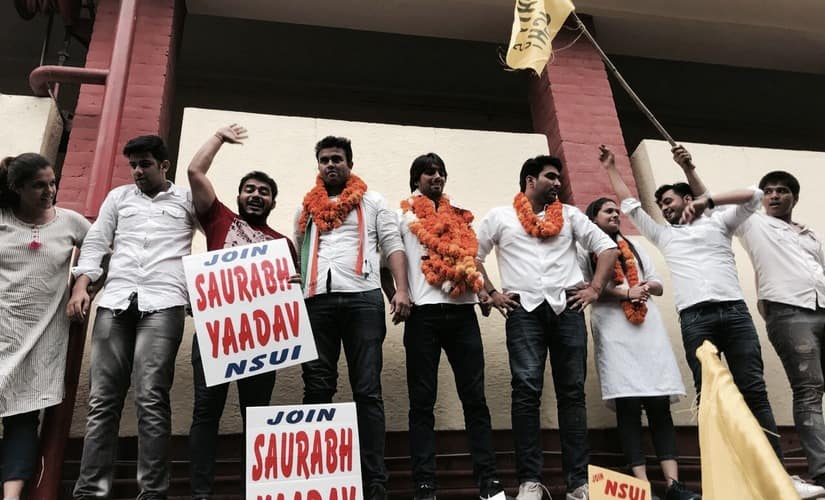It is just another humid September at Delhi University’s north campus. Sporadic showers have washed the dust off red brick walls. There is a presence of police personnel and barricades have been set up. Inside the arts faculty campus, some students sit around a table, hunched over glossy manifestos. Some others release polka-dotted helium balloons in the sky as they scream slogans for their candidates of choice. Phones buzz to the tune of “Aarambh hai Prachand”, the student politics anthem from Anurag Kashyap’s political drama Gulaal (2009) — a song which, in lyrics and rhythm, likens student politics to a war both for and against the system. Several SUVs are parked, with windows plastered with the names of candidates, mainly from the BJP’s student wing Akhil Bharatiya Vidyarthi Parishad (ABVP) and Congress’ student wing National Students’ Union of India (NSUI). At Delhi University (DU), the romance of politics precedes the purpose of politics. The reason for this is two-fold. Firstly, student parties at DU align their agendas with those of national politics, and in the process of doing that, stop innovating and discovering the lesser visible problems within their own campus. The same issues of infrastructure are repeatedly raised — like more hostels, metro passes, 24x7 libraries and laws against caste and gender discrimination in party manifestos. [caption id=“attachment_5155021” align=“alignnone” width=“825”]  Posters campaigning for student leaders in Delhi University have been pasted on cars. Pallavi Rebbapragada/Firstpost[/caption] Secondly, student politics at DU seems vote-bank driven. Why aren’t M.Phil and Phd candidates, who are nearly 5,000 in number, represented in the DUSU elections? Rajib Ray, president of the Delhi University Teachers’ Association and Professor of Philosophy at Kirori Mal College, told Firstpost that unlike in JNU, DU doesn’t cover research scholars. “No admission took place in Delhi University’s MPhil and Phd courses in the month of August. Such an issue could have been raised by a body like Delhi University Researchers’ Association (DURA) which was dissolved a decade and a half ago,” he said. He added that students aren’t indifferent towards critical issues, and cited the example of the massive student turnout at DUTA’s strike from 19 March to 23 March in protest against the government’s move with regard to funding and autonomy of 62 universities. He said that students are aware of issues that matter to them and those issues should gain ground in politics. Ray was a student member of the academic council 24 years ago. “As per the statutes of the Delhi University, the academic council has to have five meritorious members, but this practice was discontinued more than 18 years ago. Why doesn’t any party in student politics talk about this?” he asked. It also not clear why steps are not being taken to increase the number of women’s colleges participating in electoral politics on campus. Students in just five out of 22 women’s colleges cast their vote. Last year, as many as 29,765 students used the None of the Above (NOTA) option, a 12,000 increase in NOTA votes over the previous year. The disenchantment with politics is as much because of the hype and drama that is tied with it, as it is because of the absence of ‘academic governance’ from political discourse. To make a university research-intensive and ensure that a certain degree of quality publications come out of it, student leaders may have to go beyond their staid manifestos. Another community which is isolated from the election scene comprises of students from the North East. Last year, Rijum, who was pursuing his History (Hons) degree at Bhagat Singh college and hails from Arunachal Pradesh, pointed out that student unions don’t question why Hindi is a qualifying subject when students from the North East aren’t familiar with it. “People in north India treat us like foreigners because of the lack of awareness about our culture. The curriculum should have more about our history and culture,” he remarked. He further said that merely introducing anti-discrimination laws won’t help unless curriculums are sensitised to the diversity of India. Interestingly, the Delhi University has its own press, much like Oxford and Cambridge in the UK, and its Ivy counterparts on the other side of the Atlantic Ocean. Why does it not have an editorial team? Why aren’t academic articles being published in it? On the university website, this is the description of its press: “It undertakes all kinds of printing, binding and related work as and when required by the university and its departments, colleges, centres, hostels etc. Due to lack of infrastructure and staff, presently university press prints degrees, answer books, envelopes etc. and binding, re-binding of A.C./E.C. minutes, results, salary bills, registers and rest of work is being out sourced through duly approved printers.” Unlike in the west, where student activism revolves around a real threat of cuts in research funds, the issues that dominate the political narrative in student politics revolve around infrastructure and logistics. This is what Soumodip Sinha, a PhD candidate at the department of sociology, noticed during his field work on student politics on campus. He recounted the story of the time he attended NSUI’s event ‘Democracy Dialogues’ and felt like a complete outsider because it seemed like a stage only for its party cadres. He believes that there should be more inclusivity and that a composite culture needs to be developed. An event or an activity of any student party must not only be interested in gaining traction for itself through social media. [caption id=“attachment_5155051” align=“alignnone” width=“825”]  Students campaigning for the NSUI in Delhi. Pallavi Rebbapragada/Firstpost[/caption] The price of aligning student parties with national ones is that politics is driven more by the drama of perception and less by actual delivery. Bharat Khatana, state secretary of the ABVP said that fellowships and scholarships have always been top concerns for the party. Some days ago, the party organised a Chhatra Adhikaar Rally, in which the issues of fellowships for Scheduled Castes, Scheduled Tribes and OBC students were raised. “The ABVP has given time of 15 days to the government to fulfil demands like linking of scholarships with respect to price index, increase in the number of scholarships” he said. He also added that another agenda was to “expose urban Naxals in different universities.” The ABVP lost the perception game on the campus in 2017, when some of its members vandalised a seminar where JNU’s Umar Khalid was going to speak. In the same event, the DUSU president allegedly punched AISA activist Kawalpreet Kaur on her face. Kawalpreet put up a Facebook post recently, accusing members of the ABVP for assaulting her yet again. This year, the AISA has tied up with AAP’s youth wing Chhatra Yuva Sangharsh Samiti and are hoping to re-instate ‘samvaad’ into a politics dominated by money and muscle. They are also breaking into tiny groups and doing “chai pe charcha” at tea stalls in north and south campus. The newly-formed alliance hopes to leverage the disillusionment with campus politics. However, unlike JNU, most DU students don’t vote for radical left parties and the CYSS, being brand new in the game, will have to promise a break from the age-old debates that oscillate between ideologies. On the other hand, the Congress is imagined as a party of dynasties and old lineages. But this year, it has come out with a programme for first-generation college goers. “We want to ensure that first-generation students are provided with resource coordinators, social and academic counsellors and even with material translated in local languages,” said Laraib Ahmed, member of the NSUI. The absence of ‘academic governance’ in student politics can be seen in the way student bodies have not been consistently vocal about developing a consensus on the alternative to the four-year undergraduate programme. In June 2014, the University Grants Commission (UGC) sent a legal notice to the management, directing the university to immediately scrap the four-year programme, stating it that is in violation of the National Policy of Education in India. The semester system was expanded by another year, and the curriculum changed to include what are known as ‘foundation courses’ in mathematics, language and communication, information technology, data analysis, and life skills. While one side alleged that these courses simply repeated what students had learnt in school and were only going to burden them and distract them from their discipline of choice, the other side felt an inter-disciplinary curriculum could prepare a child who could compete with those passing out of IITs or professional colleges. Student politics, if it desists from duplicating the national political narrative, could find itself at the heart of the way the university reacts to its own evolution.
The issues that dominate the political narrative in student politics in Delhi revolve around infrastructure and logistics.
Advertisement
End of Article


)
)
)
)
)
)
)
)
)



